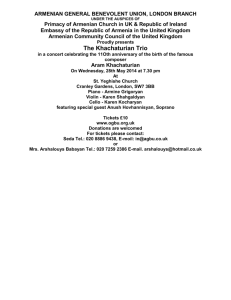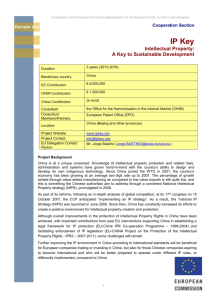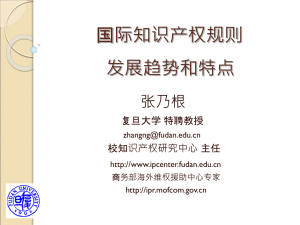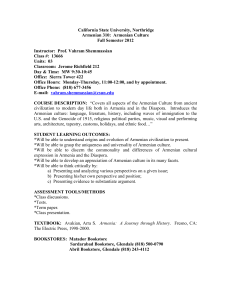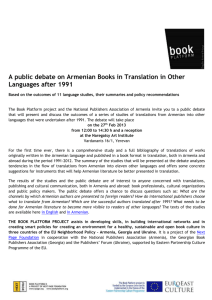Protection of Intellectual Property Rights in the IT Sector
advertisement
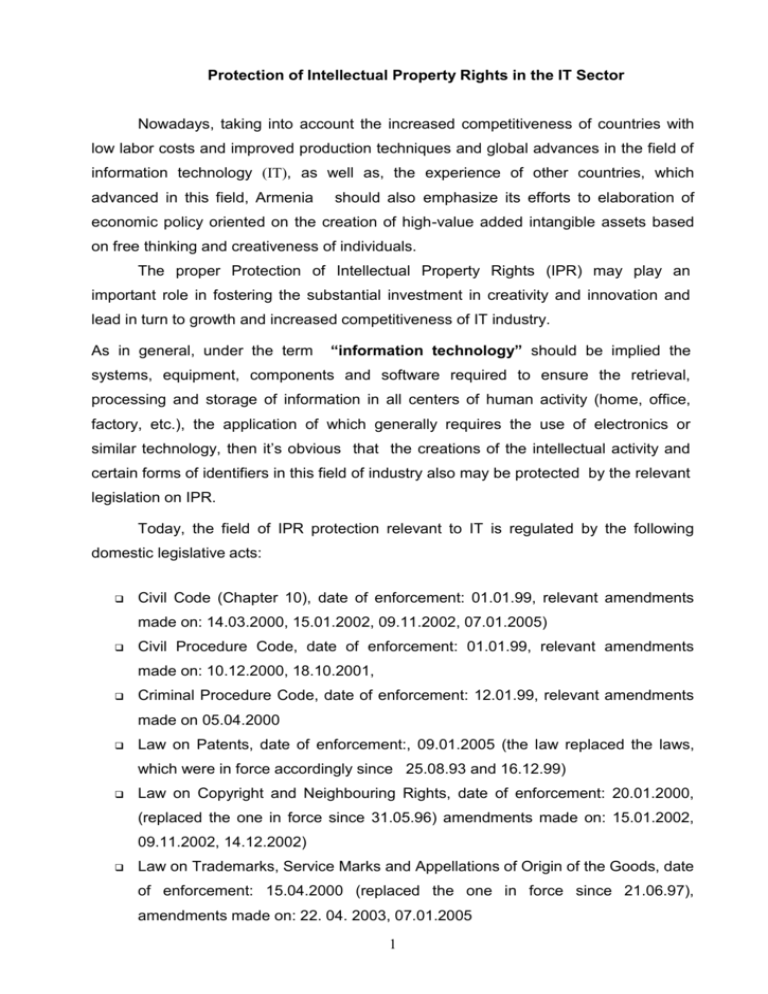
Protection of Intellectual Property Rights in the IT Sector Nowadays, taking into account the increased competitiveness of countries with low labor costs and improved production techniques and global advances in the field of information technology (IT), as well as, the experience of other countries, which advanced in this field, Armenia should also emphasize its efforts to elaboration of economic policy oriented on the creation of high-value added intangible assets based on free thinking and creativeness of individuals. The proper Protection of Intellectual Property Rights (IPR) may play an important role in fostering the substantial investment in creativity and innovation and lead in turn to growth and increased competitiveness of IT industry. As in general, under the term “information technology” should be implied the systems, equipment, components and software required to ensure the retrieval, processing and storage of information in all centers of human activity (home, office, factory, etc.), the application of which generally requires the use of electronics or similar technology, then it’s obvious that the creations of the intellectual activity and certain forms of identifiers in this field of industry also may be protected by the relevant legislation on IPR. Today, the field of IPR protection relevant to IT is regulated by the following domestic legislative acts: Civil Code (Chapter 10), date of enforcement: 01.01.99, relevant amendments made on: 14.03.2000, 15.01.2002, 09.11.2002, 07.01.2005) Civil Procedure Code, date of enforcement: 01.01.99, relevant amendments made on: 10.12.2000, 18.10.2001, Criminal Procedure Code, date of enforcement: 12.01.99, relevant amendments made on 05.04.2000 Law on Patents, date of enforcement:, 09.01.2005 (the law replaced the laws, which were in force accordingly since 25.08.93 and 16.12.99) Law on Copyright and Neighbouring Rights, date of enforcement: 20.01.2000, (replaced the one in force since 31.05.96) amendments made on: 15.01.2002, 09.11.2002, 14.12.2002) Law on Trademarks, Service Marks and Appellations of Origin of the Goods, date of enforcement: 15.04.2000 (replaced the one in force since 21.06.97), amendments made on: 22. 04. 2003, 07.01.2005 1 Law on Protection of Trade Names, date of enforcement: 07.01.2000 (replaced the one in force since 01.07.97), amendments made on: adopted by NA on 03.04.2001(date of enforcement 18.08.2001) Law on Protection of Topographies of Integrated Circuits, date of enforcement: 14.03.98 Customs Code (Section 14), date of enforcement: 01.01.2001 Law on Advertising, date of enforcement: 31.05.96 Law on Protection of Economic Competition (including the regulation of unfair competition and protection of undisclosed information), date of enforcement: 15.12.2000 Law on Making Changes and Amendments in the Criminal Code date of enforcement: 09.11.2002 Law on Putting the Criminal Code of the RA into Force, date of enforcement: 12. 05. 2003 Code on Administrative Infringements, date of enforcement: 01.06.1986 Since 22 April, 1993 Armenia became a member of the World Intellectual Property Organization (WIPO) and on September 13, 1993 acceded to the Convention Relating to the Distribution of Programme–Carrying Signals Transmitted by Satellite ( Brussels, 1974). On 17 May 1994 RA deposited a declaration of continued application of the Paris Convention for the Protection of Industrial Property, Madrid Agreement Concerning the International Registration of Marks and Patent Cooperation Treaty (PCT). Under the Agreement on Partnership and Cooperation between the RA and European Community and its 15 Member States (PCA- signed in 15.12.1995 and enforced from 01.12.1997) Armenia committed itself to accede to a number of international agreements on the protection of intellectual property. From those Armenia acceded to the Protocol Relating to the Madrid Agreement Concerning the International Registration of Marks of 1989 (from July 19, 2000), Berne Convention for the Protection of Literary and Artistic Works of 1971 (from May 03, 2000) Rome International Convention on the Protection of Performers, Producers of Phonograms, and Broadcasting Organizations of 1961 (from October 31, 2002), 2 Geneva Convention for the Protection of Producers of Phonograms Against Unauthorized Duplication of Their Phonograms (Geneva, 1971) (from October 31, 2002), Strasbourg Agreement Concerning the International Patent Classification (of 1971, amended on 1979) (from December 06, 2004) Nice Agreement concerning the International Classification of Goods and Services for the purposes of the Registration of Marks (of 1977, amended on1979), (from March 06, 2005) Vienna Agreement Establishing an International Classification of the Figurative Elements of Marks (of 1973, amended on 1985) (from March 06, 2005), WIPO Copyright Treaty (Geneva, 1996) (from March 06, 2005) The Agency on Intellectual Property of the RA (AIP) under supervision of the Ministry of Trade and Economic Development of the RA is authorized to administer IP legislation in the fields of Industrial Property and Copyright. The non-profit organization “Armauthor” operates as a collecting society to manage economic rights of copyright right holders (including right holders in the area of IT). Since, according to this and other surveys, more than 65 percent of IT professionals were software (SW) specialists (computer programmers (CPs) and computer scientists/engineers (CS/Es)), and 20 percent were computer hardware (HW) specialists, then it will be reasonable to talk about IPR protection in respect of computer programs as creations of the intellectual activity. In general, the development of computer program (or computer software) consists of two stages. But before a computer program can actually be written by its creator, the latter i.e. programmer shall define the task of the computer ( for example, calculating income tax in accordance with a series of legal rules) and shall formulate the logical steps which are to form the bases of the program (i.e. “algorithm”). However, the definition of the task and the algorithm, usually are not protected by the IPR legislations as such. For instance, the Armenian Law on Patents expressly states that algorithms for computers, mathematical methods, rules of games, methods and rules of mental or economic activities shall not be subject to legal protection. In first stage the programmer writes a program in some programming language (namely, in some artificial language consisting of specific symbols and established for expressing computer programs, for instance: Visual C, C++, Visual Basic, Java, SQL 3 Server, Oracle, Power Builder, etc.). This form of computer program, which is usually called “source code”, cannot be used by the machine as such. In second stage the source code should be transformed into a set of instructions that can be recognized by the central processing unit of the computer. Those instructions usually consist of only two different elements, symbolized by “0” and “1”, which have the effect that flow of electric current is either barred or permitted. In this machine-readable form of the program, which is usually called “object code”, the instructions consist of extremely long combinations of these two digits. As in most World Trade Organization (WTO) member countries, in accordance with Article 10 of the Agreement on Trade Related Aspects of Intellectual Property Rights (TRIPs), Article 10 of the Armenian Law on Copyright and Neighbouring Rights stipulates that all types of computer programs (expressed in any programming language and form (including application programs, operation systems, source code and object code) shall be protected as literary works. It goes without saying that the software sector is a very lively market with various new software being introduced to the public every day, and any ideas and principles for developing new products constitute an important business element for the software developers. However, while the copyright laws protect expression of software, they do not protect the underlying ideas and principles of the source code or object code. Moreover, undoubtedly, copyright provides an acceptable and appropriate form of protection for most computer programs which do not possess significant elements of novelty or originality. Copyright, however, particularly given precedents in the United States placing limits on the scope of protection against non-literal copying, is less suitable as a mean for protecting innovative works. Accordingly, the software developers not only want to prevent others from making verbatim copies of the software, but also from copying as much of the innovation that goes into the software as possible. So, they resort to patent protection for their ideas and principles that underlined the elements of the computer software as they believe they would be better protected under the patent laws. It’s remarkable that the software patent protection would be available under Armenian Law on Patents too. However, unfortunately only one patent application related to computer program was filed to the AIP since the date of its establishment (Patent Application Number P20040034 filed on 10.03.2004, “The process to promote the sale of goods and rendering of services through creation of data base and organization of at least one game in the Internet web site”, Applicant- “BI Line” Ltd, Patent Attorney4 Areg Petrosyan). Such situation in general is stipulated by the ignorance of the law amongst relevant sector of public and by the lack of proper experience of relevant attorneys and experts of the AIP. It’s already internationally recognized that the computer program may be patentable, if it forms an integral part of a process in some field of technology (physics, chemistry etc.) and one could describe the invention as a “process controlled by a specific computer program” (for instance, a computer controlled chemical manufacturing process for curing rubber), provided that the usual conditions of patentability (novelty, inventive step and industrial application) are fulfilled. This approach is based firstly on concept that the mere fact that the claims required a computer to apply a mathematical formula in controlling a process did not mean that an attempt was being made to patent the mathematical formula itself. Thus, a computer controlled process could be patentable even if the process when controlled by other means was already known as long as application of the program used to the process was not obvious. Secondly, one should remember Art.27 of the TRIPs Agreement, which states that “…patents shall be available for any inventions, whether products or processes, in all fields of technology, provided they are new, involve an inventive step and are capable of industrial application…” On the other hand European courts and the Boards of Appeal of European Patent Office (EPO) in the mid of 1980s started holding in their decisions that a technical invention which used a computer program was, in principle, patentable, although the technical invention frame did not exist in the European Patent Convention (EPC). Technical character was interpreted by the EPO as requiring, first, that an invention must belong to a field of technology and that, second, the invention must also make a technical contribution to the technological state of the art. Today, many of software companies in the USA, Europe, Japan and Russia are applying for patents in their national Patent Offices, Regional and International Patent Authorities (EPO, United International Bureaux for the Protection of Intellectual Property (BIRPI) under PCT) for their software of a technical nature and also for software carrying out new business methods on the Internet, controlling financial processes, analyzing financial data, and processing language or speech etc.. Usually they resort to the Class G06F 17/60 (Digital computing or data processing equipment or methods, specially adapted for administrative, commercial, managerial, supervisory or forecasting purposes ) of the International Patent Classification. The other way to protect computer programs is protection them, as trade secrets (or undisclosed information), by provisions concerning the prevention of unfair 5 competition and particularly, on protection of undisclosed information envisaged in Chapter 5 of the Armenian Law on Protection of Economic Competition. In accordance with this law, computer software and data base shall be inter alia considered as undisclosed, if: a) it is not, as a body or in the precise configuration and assembly of its components, generally known among or readily accessible to persons within the circles that normally deal with the kind of information in question; b) it has an actual or potential commercial value by virtue of its being unknown to third persons, there is not free access to it on a legal basis; c) it has been subject to reasonable steps under the circumstances, by the natural or legal person lawfully in control of the information, to keep it secret, and these steps may be expressed in the form of conclusion of relevant contract and/or provision of its terms, in the form of undertaking of other precautionary measures (e.g. any technological measures), by keeping the information in the information carriers of identification-in the form of documents, computer files, audio or video films, article embodying this information. As regards the enterprises, which deal with chip product “integrated circuit” ) design, they could protect (in other words, the mask works (in other words, “topographies or layout-designs of the integrated circuits”) created by them under the Armenian Law on Protection of Topographies of Integrated Circuits. However, the AIP has not yet received any application on this subject matter since the date of enforcement of this Law. As regards enforcement of existing legislation, IT and IPR related sanctions are provided in the following Articles of the Armenian Criminal Code: 1) Chapter 24 (Articles 251-257) “Crimes against safety of Computer Information”; 2) Article 158 “Violation of Copyright and Neighbouring Rights”; 3) Article 159 “Violation of Patent Rights”; 4) Article 197 “Illegal Use of Trade marks”; 5) Article 198 “False Advertisement” 6) Article 199 “Illegal Gathering and Promulgation of the Information Constituting Banking or Commercial Secret”; Despite Armenia’s considerable achievements in the process of legislative reform, undertaken under auspice of WTO Accession and PCA implementation, there 6 are still number of shortcomings and uncertainties in the existing legislation, as well as inconsistencies with internationally accepted rules. For instance, in spite of Armenia’s accession to the Strasbourg Agreement Concerning the International Patent Classification that provides a special Class G06F 17/60 (Digital computing or data processing equipment or methods, specially adapted for administrative, commercial, managerial, supervisory or forecasting purposes), the Armenian Law on Patents or its bylaw do not provide any clarification concerning the ways of computer program protection: The Draft Modified Law on Copyright and Neighbouring Rights, which will envisage a lot of provisions concerning: sui generis right affordable to database makers; circumvention of technological measures designed to prevent or restrict acts not authorized by the rightholders; removal or alteration of the electronic copyright-management information attached to the work distributed on network; exclusive right to make available to the public copyright works or any other subject-matter by way of interactive on-demand transmissions over networks, is still in the stage of consideration. On account that at present, some domestic companies elaborate a new software through an improvement of existing computer programs licensed by a customer under contractual licenses, there may be some licensing practices or conditions, which could restrain competition and may impede the development of domestic industry. In this respect, appropriate measures to prevent or control such practices that may in particular cases constitute an abuse of IPR having an adverse effect on competition are lacking in the existing Armenian legislation. For instance, Article 11of the Law on Protection of Economic Competition states that any business activity or conduct, that contravenes the present Law or commercial usage and impairs the good-faith (honesty, fairness, verity, impartiality) principles in the relations amongst the competitors or in their relations with consumers shall constitute an act of unfair competition and shall be prohibited. However, in the mentioned law there is some uncertainty concerning the examples of impairments of good-faith principles, in particular, on concluding such contractual licenses that include the following kind of conditions: a) preventing licensee to challenge the validity of the right in respect of license subject matter intellectual property object; 7 b) inducing licensee to accept a license for using multiple results of intellectual activity (package licensing), if it is not stipulated by the necessity for a technically satisfactory exploitation of the certain result of intellectual activity or for guaranteeing the effectiveness of the licensed technology; c) inducing licensee to assign or transfer the exclusive right to use improvements of a license subject matter result of intellectual activity to the licensor (exclusive grantback conditions); d) inducing licensee to purchase implements and materials needed to use the licensed result of intellectual activity only from the licensor (tie-in conditions), if it is not stipulated by the necessity for a technically satisfactory exploitation of the certain result of intellectual activity or for guaranteeing the effectiveness of the licensed technology or for maintenance the secrecy of the licensed undisclosed information. As regards to the protection of means of goods’ and services’ identification, enough amount of bad faith practices intended to prevent the access of competitors to the market may be listed practically. Meanwhile, the Armenian Law on Trademarks, Service Marks and Appellations of Origin of the Goods is still silent about opportunity of the Well-Known trademarks’ owner to request a cancellation of granted protection of marks registered in bad faith (see Article 6 bis of the Paris Convention for the Protection of Industrial Property of 1967). In particular, Article 28 of the mentioned Law states that the registration of a trademark may be asserted and recognized as invalid either fully or partially during the whole of the period of its validity, if it is produced in contravention of the requirements of Article 11 of this Law. But Article 11 of the mentioned law relates to absolute grounds for refusal of trademark’s registration, where, in truth, is a reference to a prohibition of registration of marks, which contradict to rules preventing unfair competition (business practice). However, neither mentioned law, nor the Law on Protection of Economic Competition make no mention about mark’s registration made in bad faith with the intention to prevent the access of competitors to the market. In this respect, an experience of European countries is vivid (see Article 51 (b) of the Council Regulation (EC) No 40/94 of 20 December 1993 on the Community trade mark). Furthermore, Article 16 (2) of the TRIPs Agreement distinctly states that in determining whether a trademark is well known, Members shall take account of the knowledge of the trademark in the relevant sector of the public, including knowledge in the Member concerned which has been obtained as a result of the promotion of the trademark. However, after the amendments made on 07.01.2005, 8 in accordance with Article 21.1(2) of the Armenian Law on Trademarks, Service Marks and Appellations of Origin of the Goods, a mark shall be recognized as well known in the Republic of Armenia, if it became known only to the relevant circle of consumers (ignoring knowledge of the trademark in the relevant business sector, as well as, knowledge, which has been obtained as a result of the promotion, advertising of the trademark). At present the most of domestic IT companies have registered their Domain names on the Internet, which are intended to perform not only the technical function of facilitating connectivity between computers through the Internet, but to be used, as identifiers of their activities, products or services during the advertisement through the Internet. However, owing to the fact that the domain names system is usually privately administered by non-governmental organizations without any functional limitation and any legislation adopted by the government of a country concerned, domain names have come into conflict with trademarks. As a result, a number of unfair practices are observed, which include the bad faith registration as domain names of well-known and other trademarks in the hope of being able to sell the domain names to the owners of those marks, or simply to take unfair advantage of the reputation attached to those marks. With the aim to prevent such practices, the Armenian Registrars of .am Top Level Domains (AM Hostmaster and Armenia Network Information Center) in their Policies reserve the right to suspend and/or revoke the registered Domain name if it is proved that the provided information/documents are not true, truthful, complete, as well as, in a case when the domain name is used for any illegal purposes. But it’s unclear on what party shall be placed a burden of proof, or in what bodies shall be proved or asserted the legality of the mentioned information, documents or the use. For certain misdemeanors mentioned in Armenian Laws on Copyright and Neighbouring Rights, on Trademarks, Service Marks and Appellations of Origin of the Goods it is provided that any person, who commits such minor offences, shall incur liability under the procedure defined by the legislation of the Republic of Armenia. However, in reality the relevant remedies are not provided in the existing legislation (particularly, they could be provided in the Code on Administrative Infringements). . However, it is not sufficient to protect IP objects just under legal provisions. The incentive to create an IP original object will dry up, if the adequate remuneration is not paid to the real authors. This factor is very crucial in the age of the globalization of economic activity and the increasing mobility of 9 employment. Unfortunately, domestic IT companies in their contracts with employees don’t provide any clauses concerning remunerations (royalties) due to genuine authors of IP creations. Whereas, as early as on December 28, 2000 the Government of Armenia announced the IT industry as a priority sector of the Armenian Economy, and in 2001 established the IT Development Support Council under the chairmanship of the Prime Minister, and adopted a Concept for the Development of the IT Industry, the corresponding legislative amendments for elimination of above mentioned shortcomings and uncertainties and encouragement of creative activity in the sector will require urgent actions of the Government and mentioned Council in the nearest future. The mentioned legislative reform will be more effective if the recently established non- governmental (public) associations as “pressure groups” are actively involved in it. With the aim to promote farther collaboration between IT companies and educational, scientific and R&D institutions, as well as, to facilitate the growth of the creative activity thereof, could be useful for mentioned institutions (first of all for educational institutions).to provide for in the “Law on state duty” of the RA favorable conditions on levy of state fees for some acts of legal effect related to the legal protection of Industrial Property objects. As regards Domain name registration, with the aim to ensure that speculative and abusive registrations are avoided as far as possible, it’s recommended to take into account the European experience (see, Commission Regulation (EC) No 874/2004 of 28 April 2004 laying down public policy rules concerning the implementation and functions of the .eu Top Level Domain and the principles governing registration). Taking into account the lack of experience of interviewed companies in concluding relevant contracts on software production and further transfer of developed technologies, IT Development Support Council should undertake appropriate measures to draft a set of model (template) contracts. Ruben Kalashyan-Expert on Intellectual Property Affairs © 2005 R. Kalashyan. 10
